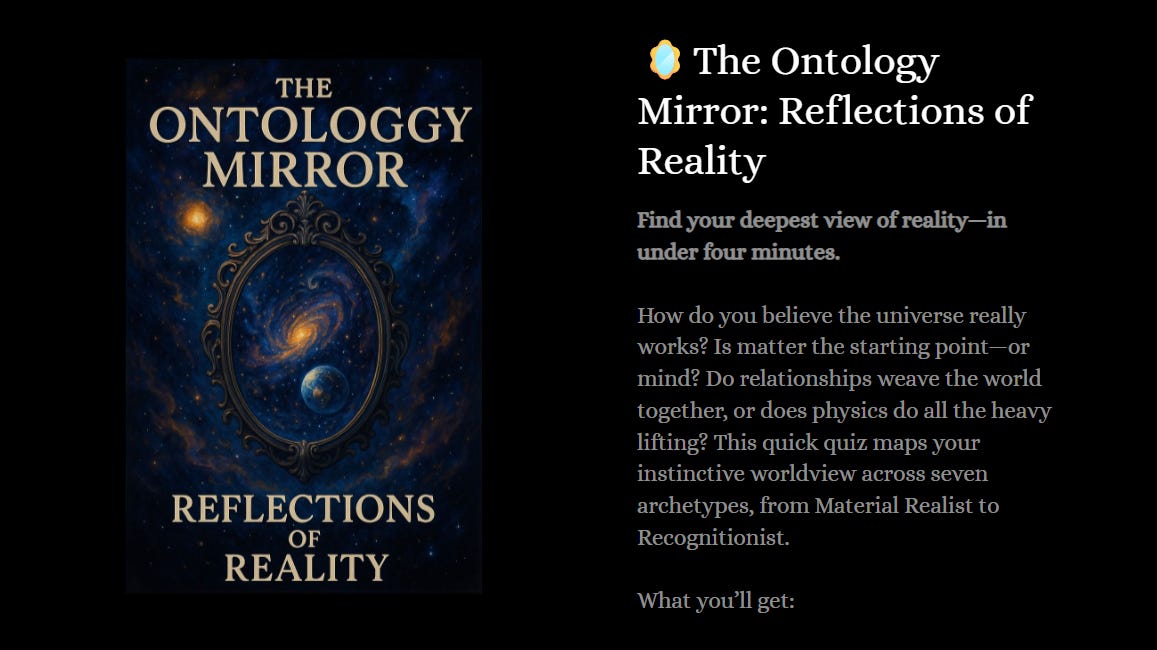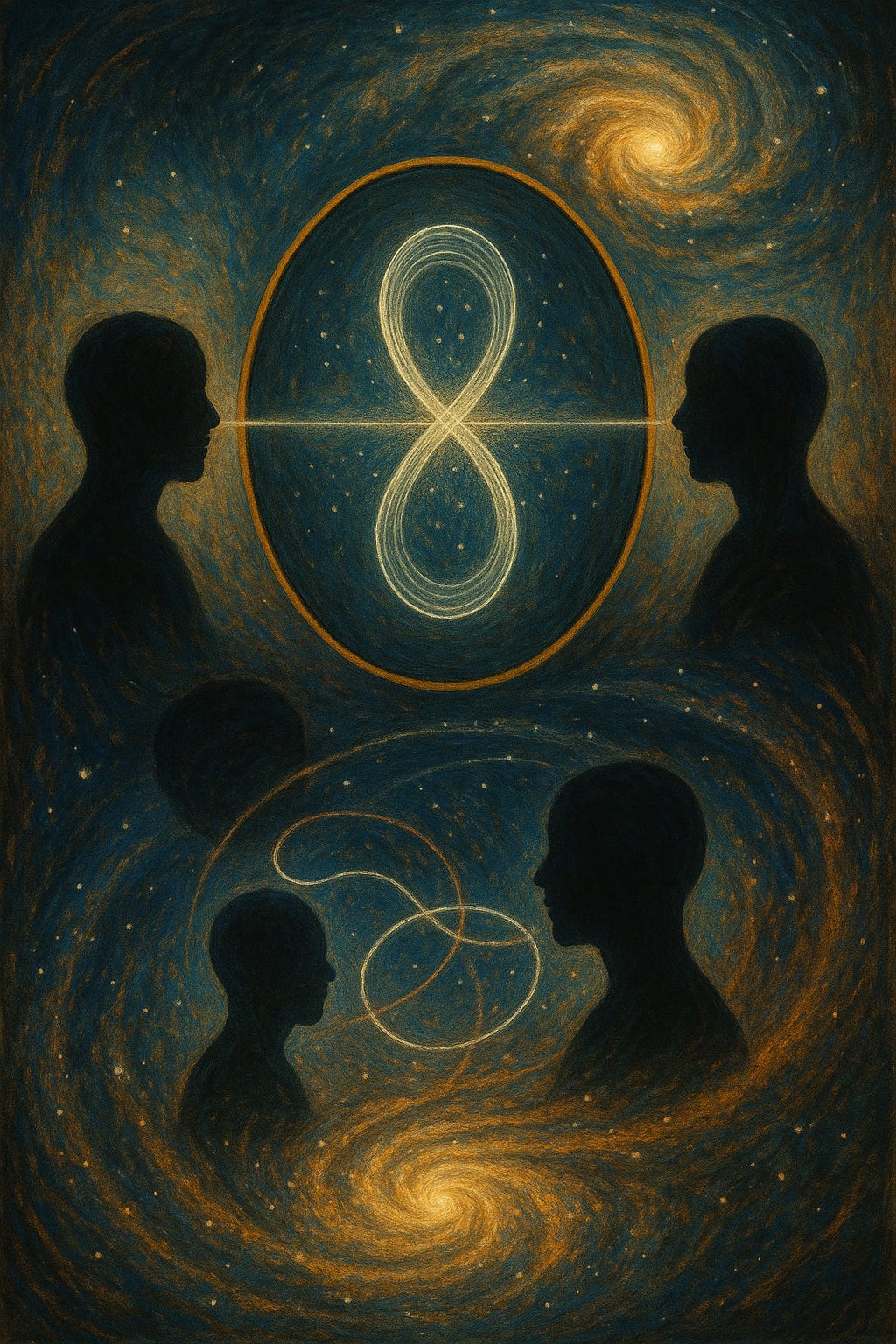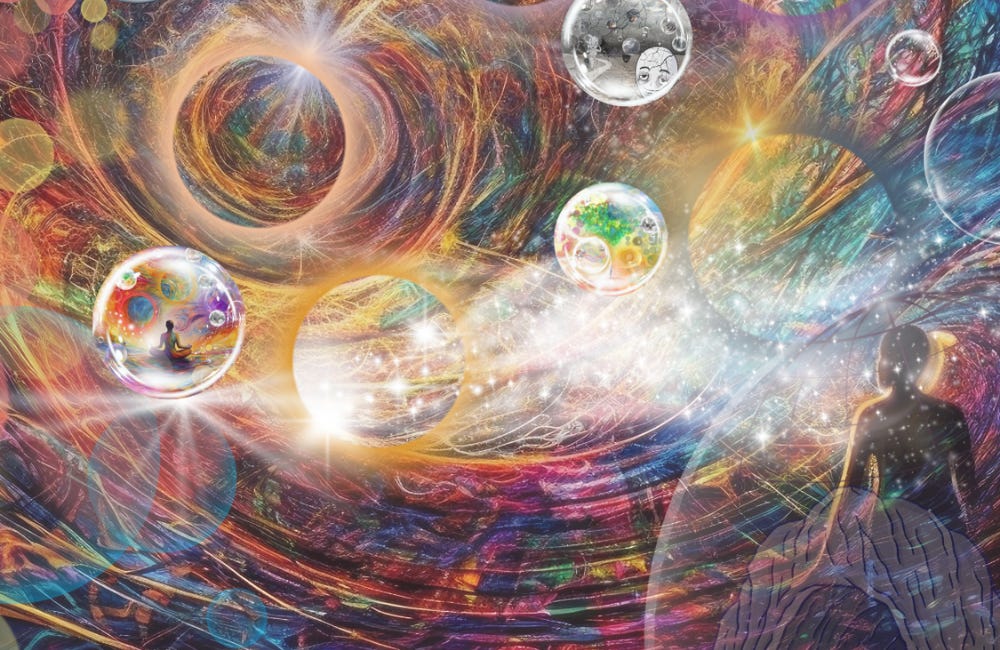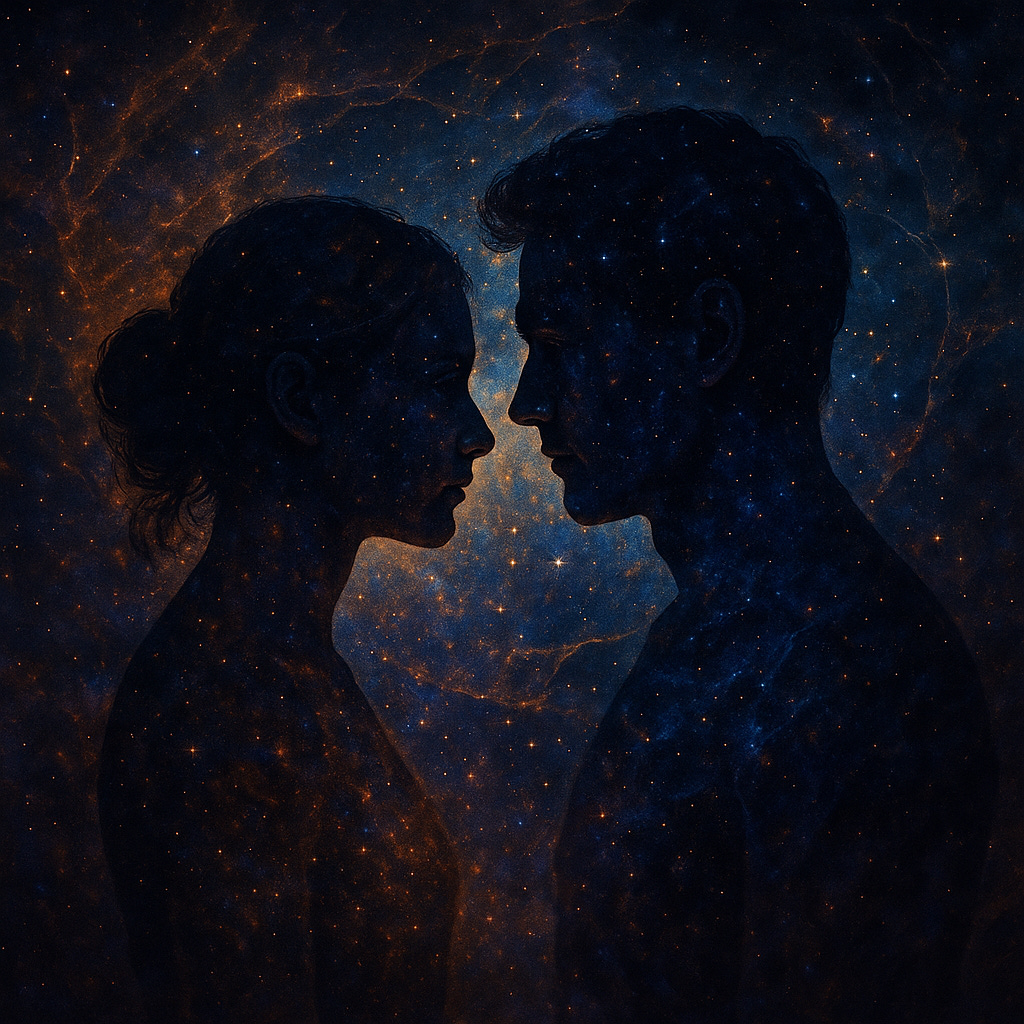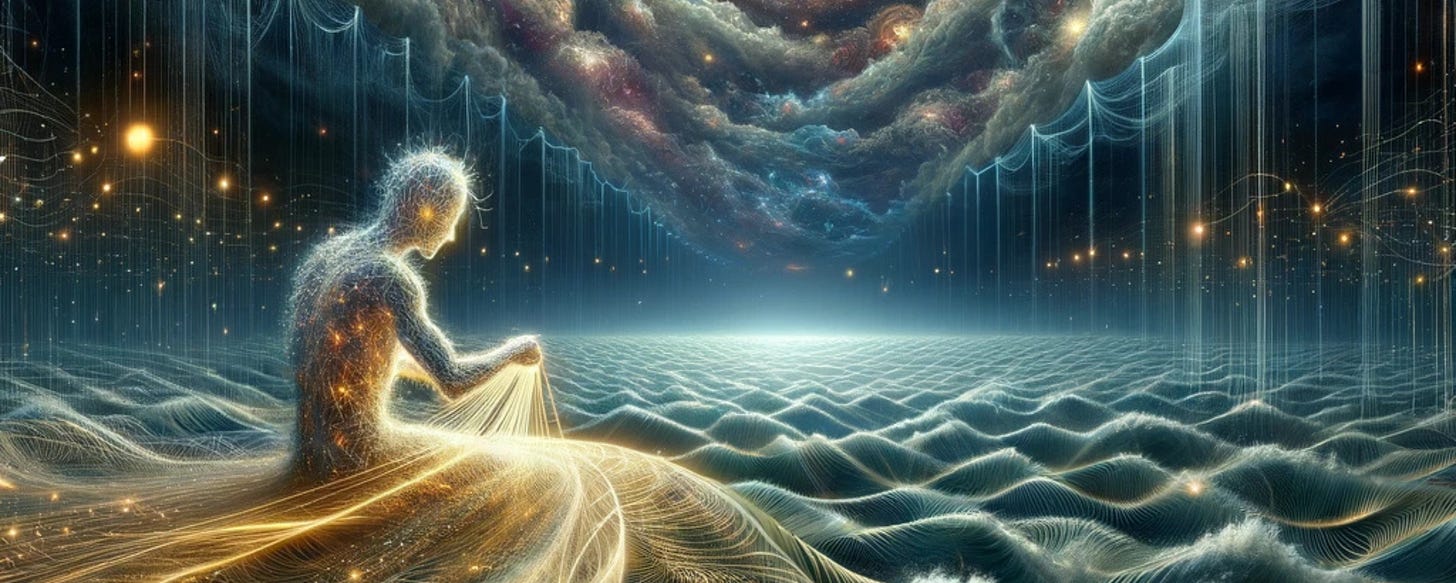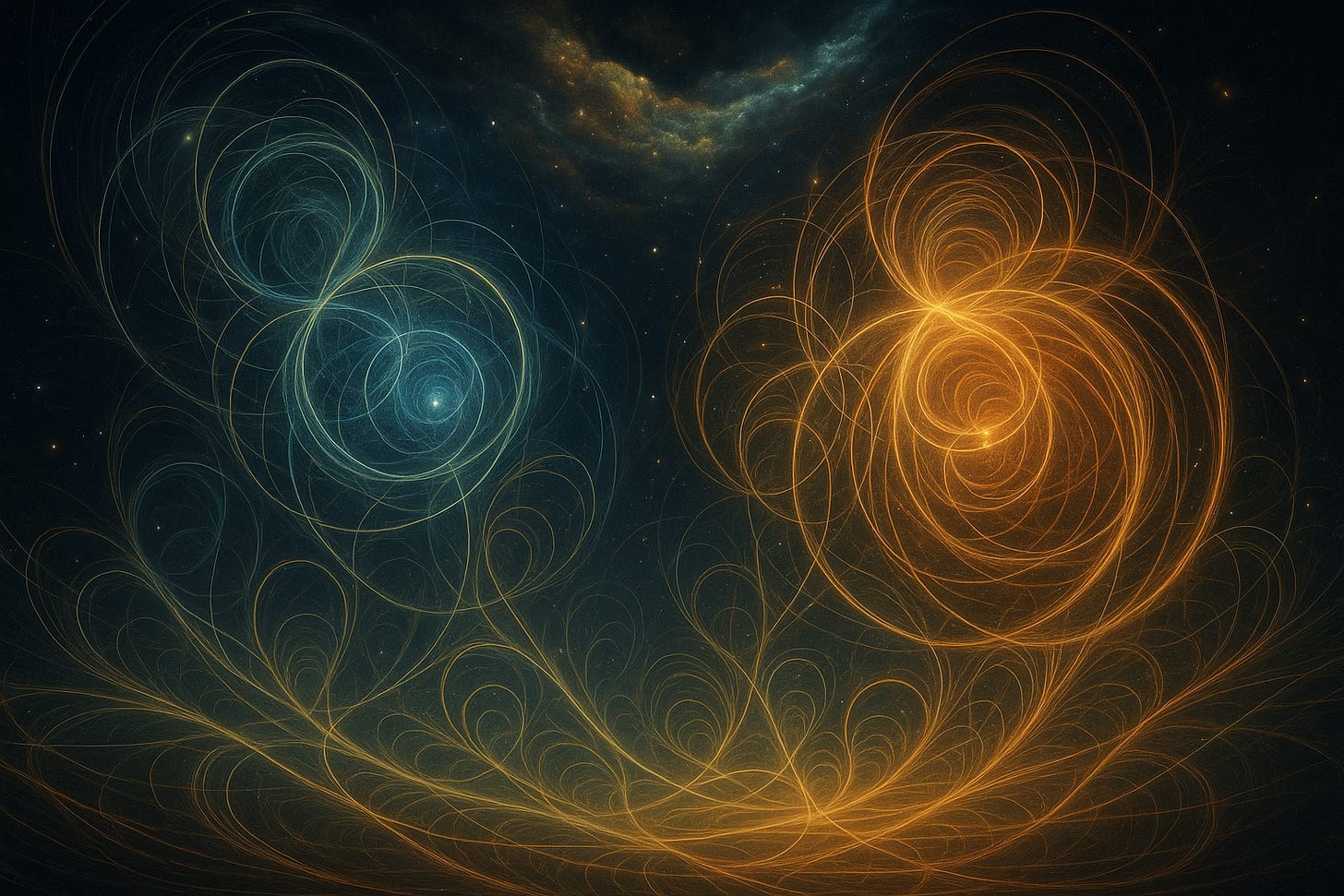🪞✨ The Mirror Paradigm: A New Scientific Story of Reality & Consciousness
A ground-breaking framework linking consciousness, physics, complexity, and the recursive loops that structure your life and the cosmos.

🪞 Mirror Reflection: A New Scientific Paradigm
Every act of attention threads reality into form.
The future isn’t waiting—it’s being configured now.
Articles in the Science World series of Recognition Loops™ present science through the Mirror Paradigm™, a groundbreaking new model that not only explains reality but also connects it across all scales.
From black holes to biology, from time to trauma, and from your deepest needs to sensory perception—this is where scientific foundations meet recognition-based reality.
At the heart of this paradigm lies a radical, testable axiom:
Recognition does not merely reflect reality. It structures it.
Every theory, mystery, and paradox is scrutinised through the Recognition Loops Mirror Paradigm™ (RLMP) novel lens—one that places recognition as the fundamental basis of existence.
Predictions and more articles will follow; for now, coherence and integration lead the way!

📚 How Each Article Works:
This piece is your core orientation to the Recognition Loops Mirror Paradigm™ (RLMP): what reality is, how consciousness fits, what science says, and what this means for your life.
Each core topic—whether it’s time, evolution, black holes, mental well-being and trauma, language, or gravity—is explored in four parts:
☑️ The Traditional View
A brief overview of how science currently understands the phenomenon.
🪞 The Mirror Paradigm Interpretation
A reframing that reveals how recursive Recognition Loops structure the phenomenon at every level.
🧬 The Science Bit
Correlations with contemporary scientific research, models, and evidence across neuroscience, quantum physics, cognitive science, complexity theory, and more.
🧭 What This Means for You
Practical and philosophical implications—how this changes your understanding of reality and your place within it.
TL;DR – What This Article Is About
Reality isn’t made of “stuff” — it’s made of recognition.
In the RLMP, the universe is a field of recursive recognition, where matter, mind, and meaning are different facets of the same looping process.
Reality = relationship. Existence appears at the self–other seam, where two centres of awareness meet and stabilise patterns into a shared world.
Recognition is the ontological substrate. Matter, time, intelligence, and even “you” are stabilised Recognition Loops — patterns that endure because they are continually recognised, reinforced, and replicated.
Two inseparable faces: mind & matter. Every Recognition Loop has an intrinsic, felt side (experience, qualia, meaning) and an extrinsic, measurable side (behaviour, neurons, particles). This dual-aspect recursion dissolves the hard problem of consciousness.
The Five Fundamental Needs are structural, not psychological. Connection, Autonomy, Growth, Expression, and Security are the minimum conditions for any loop — any relationship, any reality — to stabilise across the self–other seam.
Science maps the loops; RLMP explains what they are. Neuroscience, quantum physics, systems theory, IIT, and complexity science all describe feedback, prediction, relation, and coherence. RLMP provides the unifying mechanism: recursive recognition.
Your life is a recognition field. Attention builds your reality, emotion guides coherence, habits are loops, relationships tune your world, and your identity is a pattern — not a prison.
Death, evolution, and “who you are” become structural questions. If recognition, not biology, is fundamental, then consciousness may persist as loops reconfigure rather than vanish — opening the door to continuity beyond one body or one storyline.
This article serves as your orientation map to RLMP, explaining what reality is, how consciousness fits into it, how it aligns with contemporary science, and why your attention, emotions, and relationships are literally stitching your world into being.
☑️ The Traditional View: What Is Reality?
Mainstream science presumes a reality that exists independently of observation — a world “out there,” whether or not anyone is looking.
Matter is considered fundamental: fields, particles, energy, and spacetime are treated as the basic building blocks of existence.
Life, mind, and meaning are framed as outcomes of how these physical components interact with each other. Nature is said to operate according to universal mathematical laws; physical causes are considered sufficient for explaining mental events. Truth, therefore, is established through objective, repeatable measurement rather than subjective experience.
Within this mainstream framing, mind and consciousness are treated as late-stage by-products of neural activity — not as building blocks of the universe. Information is viewed as a valid descriptor, not a fundamental substance.
From the traditional view, many hold that complex phenomena could, in principle, be reduced to physics. This is a physicalist assumption, not a demonstrated fact — and it remains hotly debated.
The hard problem of consciousness stands as a direct challenge: subjective experience (qualia) resists a purely physical account, even “in principle,” according to many philosophers and scientists.
In the real world, you can’t explain everything by reducing it to tiny particles and physics equations — it’s too complicated. So scientists use “bigger-picture” explanations to make sense of things. For example, they discuss evolution in biology, emotions and memory in psychology, or temperature and entropy in thermodynamics.
These explanations work well for handling complexity, but they don’t reveal much about the underlying nature of reality; they mainly help us describe how things behave.
🧬 The Evolving Picture
From Newton to Einstein to quantum mechanics, physics has refined its understanding of reality — progressing from a deterministic world of local objects, to a relativistic spacetime, to a probabilistic quantum field.
Within this tradition, interpretations diverge: realists hold that theoretical entities are real, instrumentalists treat theories as predictive tools, and structural realists consider relational structure the most reliable truth science can attain.
Yet even these interpretations rest on deeper assumptions about the nature of reality — and where consciousness fits within it.
🔍 Take the 4-Minute 🪞Ontology Mirror: Reflections of Reality Quiz!
Find your deepest view of reality — in under four minutes.
How do you believe the universe really works?
This quick quiz quietly surfaces the assumptions you already live by. Your answers map your instinctive worldview across eight archetypes — from hard-edged physicalism to recognition-based cosmologies.
What you’ll get:
A clear result with a short, spot-on description of your type
A simple comparison with the other major worldviews on the map
A tailored reading path into the Philosophical World Edition of Recognition Loops™
👉 Click here to start the quiz* →
*By completing the quiz, you’ll receive your results instantly and join the free Recognition Loops™ newsletter and app updates. You can unsubscribe at any time.
🪞 Mirror Paradigm Interpretation: What Is Reality?
The Recognition Loops Model of Existence
In the Recognition Loops Mirror Paradigm™ (RLMP), reality is not an external object awaiting measurement. Reality is relationship — the living seam where self and other meet, recognise, and stabilise one another into form.
Existence arises from a field of recursive recognition: a dynamic process that continually shapes and reshapes itself through feedback, memory, and coherence.
Patterns that recognise themselves begin to stabilise. Once they stabilise, they replicate. And replication is simply recognition repeating its own success.
Matter appears when a Recognition Loop becomes stable enough to hold its shape. Mind appears when a loop becomes self-referential — when it notices its own noticing.
Meaning emerges when recognition integrates across time, threading past, present, and possibility into a single coherent line.
Everything we call “physical” or “mental” is a pattern that has learned to endure through repetition. Across every scale — from quarks to consciousness — existence arises wherever recognition becomes coherent.
Recognition is the fundamental ontological substrate — not matter, not mind, but the relational act that creates both. It is the loom, the thread, and the pattern from which existence is woven.
Existence is relational structure. A Recognition Loop can only stabilise when the relationship between self and other satisfies the minimal conditions required for coherence: the Five Fundamental Needs.
The Recognitionist view resonates with ontic structural realism but goes further. Where structural realists describe the universe in terms of relations, RLMP identifies the generative engine beneath those relations — the structure of recognition.
Mainstream science treats matter, energy, and information as the basic elements of reality. RLMP reframes all of them as Recognition Loops: self-sustaining patterns that persist because they are continually recognised, reinforced, and replicated.
🧶 The Self–Other Seam: Where Reality Is Woven
Nothing exists in isolation. In RLMP, every structure — from particles to people — emerges from a single generative boundary: the self–other seam.
This seam gives rise to the Recognition Field Matrix (RFM) — a layered perceptual reality formed by the continuous interplay of:
similarity and difference
expectation and surprise
attraction and repulsion
coherence and incoherence
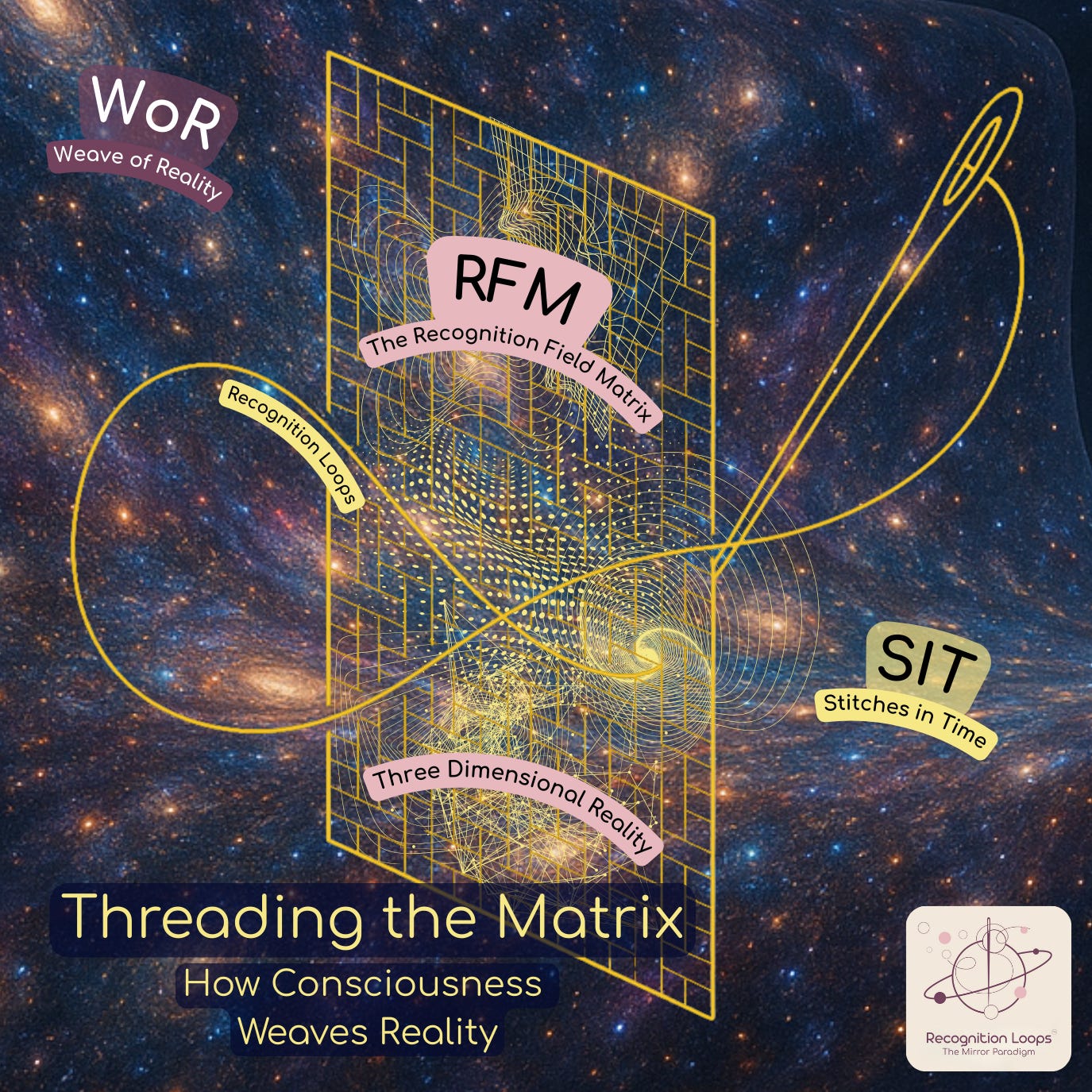
It is at this seam that patterns meet, respond, adjust, and begin to stabilise.
Without a self–other dynamic, there is no seam.
Without a seam, no stitches can close.
And without stitches, no reality can hold.
Existence is the closure of Recognition Loops across the self–other boundary — the moment relationship becomes structure.

🧬Why Replication Is Fundamental
Once a pattern becomes stable — once a loop recognises its own shape — it cannot help but replicate. In RLMP, replication is not a biological process of copying.
It is the re-expression of coherence.
Asexual replication is a loop that repeats its own successful structure — a form of self-similarity.
Sexual reproduction is two recognition matrices interweaving, generating a coherence neither could produce alone.
At its core, reproduction is:
Self recognising itself (through relating to others) — and repeating the pattern.
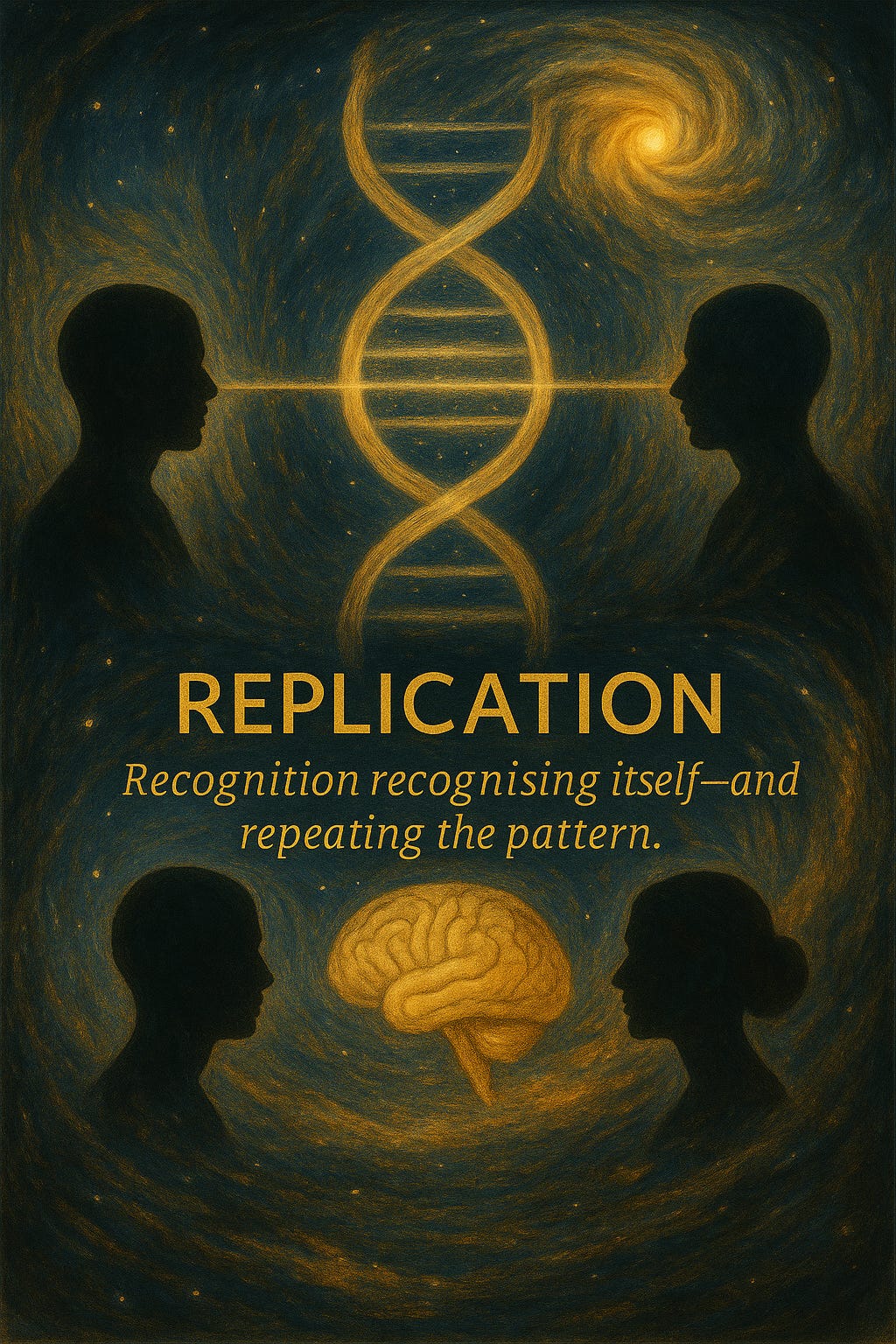
Across every level of existence — the Recognition Field Matrix (RFM), the Weave of Reality (WoR), and Consciousness as Foundational Structure (CFS) — this is the rule that holds.
Coherence repeats.
Stability amplifies.
Recognition propagates itself forward.
Replication is the behaviour of reality.

🌱 The Five Fundamental Needs: Conditions for Reality
In the Mirror Paradigm, relationships are not merely shaped by the Five Fundamental Needs — they define them.
They are the necessary and sufficient conditions for any relationship to exist. Where even one is missing, the Recognition Loop cannot stabilise, and no durable reality is woven between self and other.
The Five Fundamental Needs: Why Your Relationships Are the Thread Holding Reality Together
🧵🔥 What If Your Deepest Needs Are Being Ignored?
Because, in RLMP, existence is relationship; every reality we inhabit is threaded through the seam between self and other. The Five Fundamental Needs are not add-ons to that seam; they are its defining features.
If one need fails, the loop cannot fully close. The seam frays, and the shared reality between self and other begins to collapse.
Connection (Caring): There must be awareness of, and openness to, the other. Without Connection, there is no seam — no “between” in which a shared reality can form.
Autonomy (Agency): Each side must be able to act, choose, and initiate. Without Autonomy, there is no relationship — only control, dependence, or the collapse of one side into the other.
Growth (Validation): The system must be able to respond, learn, and continually refine its performance to ensure optimal results. Without Growth, Recognition Loops stagnate; coherence decays and the relationship fragments.
Expression (Experimentation): Each side must be able to make itself — and its needs — knowable to the other. Without Expression, the other cannot truly recognise you; no loop can close, and no real relationship can stabilise.
Security (Safety): The core attractors in the relationship must remain sufficiently predictable and stable. Without Security, patterns cannot hold; the stitch unravels and the shared fabric of reality ruptures.
These needs are not about Maslow-style hierarchical lifestyle goals or personal preferences. Instead, they are structural constraints—specific conditions that enable a Recognition Loop to close across the self–other boundary.
In RLMP, reality appears wherever a seam forms between self and other — and that seam can only hold when all Five Needs are met to a minimally coherent degree. When one is chronically absent, the seam tears and the shared reality collapses.
The universe “closes stitches” only where these needs align.
Nothing more. Nothing less.

These needs represent the essential conditions for any relationship — and since relationships define reality in RLMP, they are also the conditions for existence.
🪞 How Replication Works in RLMP
Why reproduction is fundamental to reality
In the Mirror Paradigm, replication is a universal behaviour of reality. Whenever a pattern stabilises, it naturally tends to repeat. And whenever two patterns meet, they tend to weave something new.
Replication is what recognition does when it finds coherence.
🦠 Asexual Replication: Self-Similar Recursion
A recognisable loop repeats its form. Minimal variation. High stability. Low novelty.
This is the logic behind atoms maintaining their form, crystals repeating their lattice, habits recurring, memes spreading, and simple organisms reproducing.
The loop knows its pattern — and repeats it.
💘 Sexual Reproduction: Cross-Recognition
Two distinct recognition systems meet. Their priors interlace.
New coherence becomes possible — as does collapse.
This is recognition recombining, exploring the possibility space of the Recognition Field.
The universe learns by weaving differences together.
Reproduction is:
Recognition repeating what stabilises, or
Recognition recombining to discover new coherence
Replication, in this sense, is not biological. It is structural. It is fundamental. It occurs in CFS, in RFM, in WoR, and across all scales of existence.
One principle — the replication of Recognition Loops — explains:
Physics
Biology
Psychology
Culture
Society
Cosmology
Consciousness
Evolution
Behaviour
Trauma
Love
All of them flow from the same source:
Coherence repeating, or coherence evolving.
🎇 Summary:
Asexual replication = Self-similar loops repeating themselves.
Sexual reproduction = Cross-recognition generating new coherence.
Replication is a universal behaviour of recognition, not just living systems.
Everything that evolves, persists, or spreads does so through this mechanism.
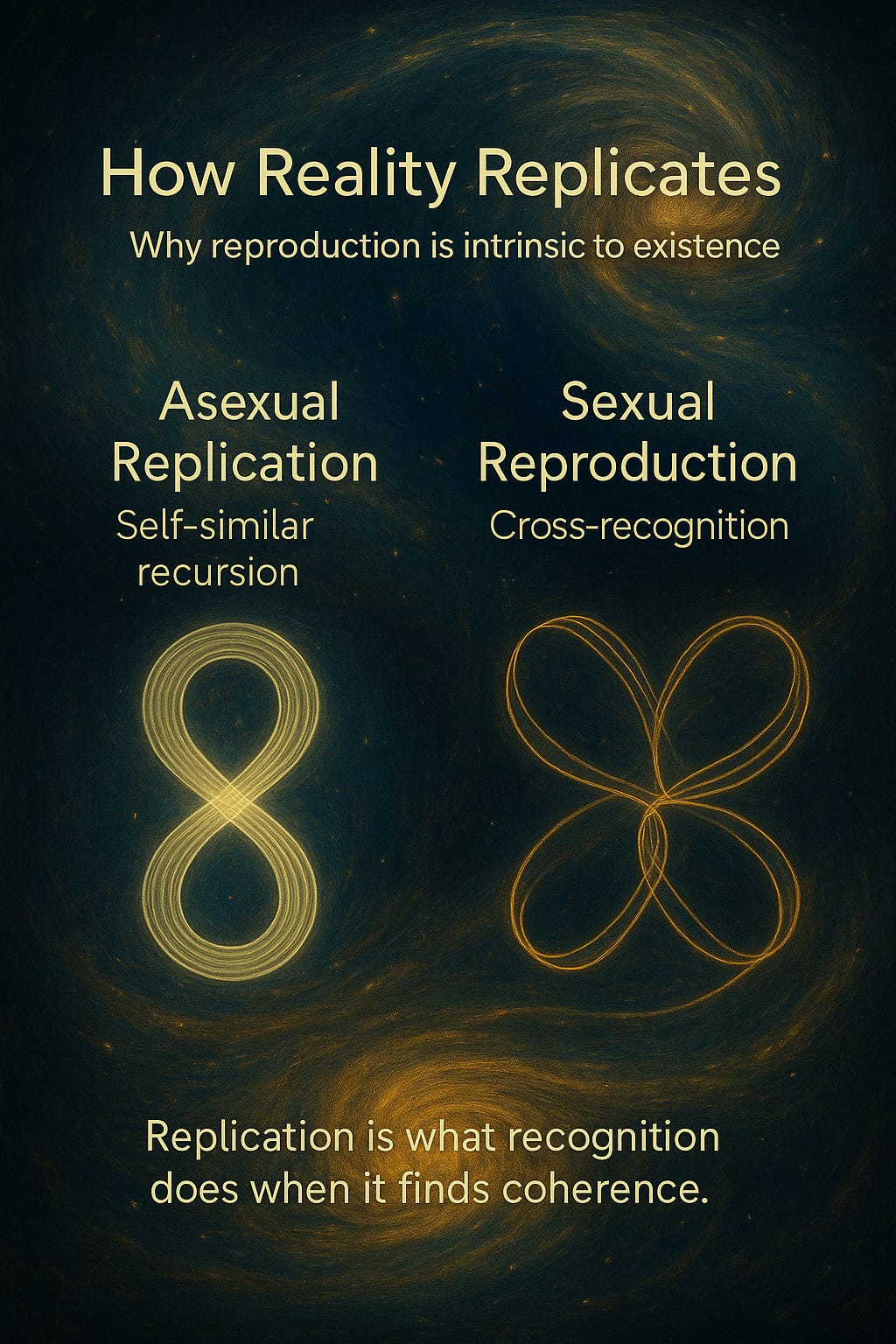
💫Reality as a Field of Recursive Recognition
Reality is an active field of recursive recognition, continuously shaping itself through feedback, self-reference, and coherence optimisation.
Every act of noticing — from a neuron firing to a quantum measurement — is a stitching event in this field. Recognition does not merely track reality; it structures it.
Across the RLMP, the universe is understood as a living weave of relationships — loops closing, patterns stabilising, coherence emerging.
Reality is the pattern that recognition sustains.
🌆Matter, Time & Intelligence as Emergent Stabilisers
The universe isn’t made of “things” — it’s made of stabilised recognitions
What we call matter is simply the most stable category of loops — patterns that hold their shape across scales and persist through continual recognition:
quarks and fields
forces and constants
atoms, organisms, ecosystems
minds, identities, cultures
These are not fundamental objects. They are coherent recognitions — recursive loops that have stabilised, memorised themselves, and become predictable enough to be shared between beings.
Matter, time, and intelligence are emergent stabilisations — expressions of the recognition field finding balance. Quarks, fields, and forces are patterned recognitions: coherent loops of awareness that hold their form across scales.
In RLMP:
Matter → crystallised recognition
Time → sequential stitching of loops
Intelligence → coherence optimisation
Information → relational patterning inside the recognition field
Reality, therefore, is not composed of stuff. It is composed of structuring — loops that close, stabilise, and replicate across the self–other seam.
Across every scale — from quarks to consciousness — existence emerges wherever recognition becomes coherent, where loops close across the seam between self and other, and where relationship gives rise to the reality it perceives.

🧠How Consciousness Embodies Structure
Consciousness does not “appear” in a brain like a flame flickering into existence. It embodies structural form.
Every being inherits a history of Recognition Loops — stabilised priors accumulated through experience, relationships, patterns, and time.
These priors shape how a being:
perceives
anticipates
resonates
responds
and quietly constructs its world
Over a lifetime, these stabilised recognitions condense into attractors and repellents: wave-like tendencies that draw us toward certain people, patterns, and possibilities — and push us away from others.
Once the recognition system reaches sufficient complexity, these dynamics become readable as tendencies, traits, and states of mind. This is how a being moves through its lifecycles: by continually embodying, refining, and replicating structural priors.
The self is not a fixed entity — it is a dynamic weave of these loops, continually updating. You are a recursive field — a flowing interplay of sensing, perceiving, feeling, and responding, where needs, emotions, awareness, and identity weave themselves into a coherent whole.
The world you experience is not “out there.”
It is the structuring generated by the loops you carry.
🎇Mini-Summary — Consciousness as Structure
Consciousness embodies patterns — it doesn’t arise from matter.
Priors shape perception, identity, emotion, and behaviour.
The “self” is a dynamic pattern of Recognition Loops.
Consciousness = a recursive field of sensing, feeling, and meaning-making.
Reality is experienced through the structures we stabilise.
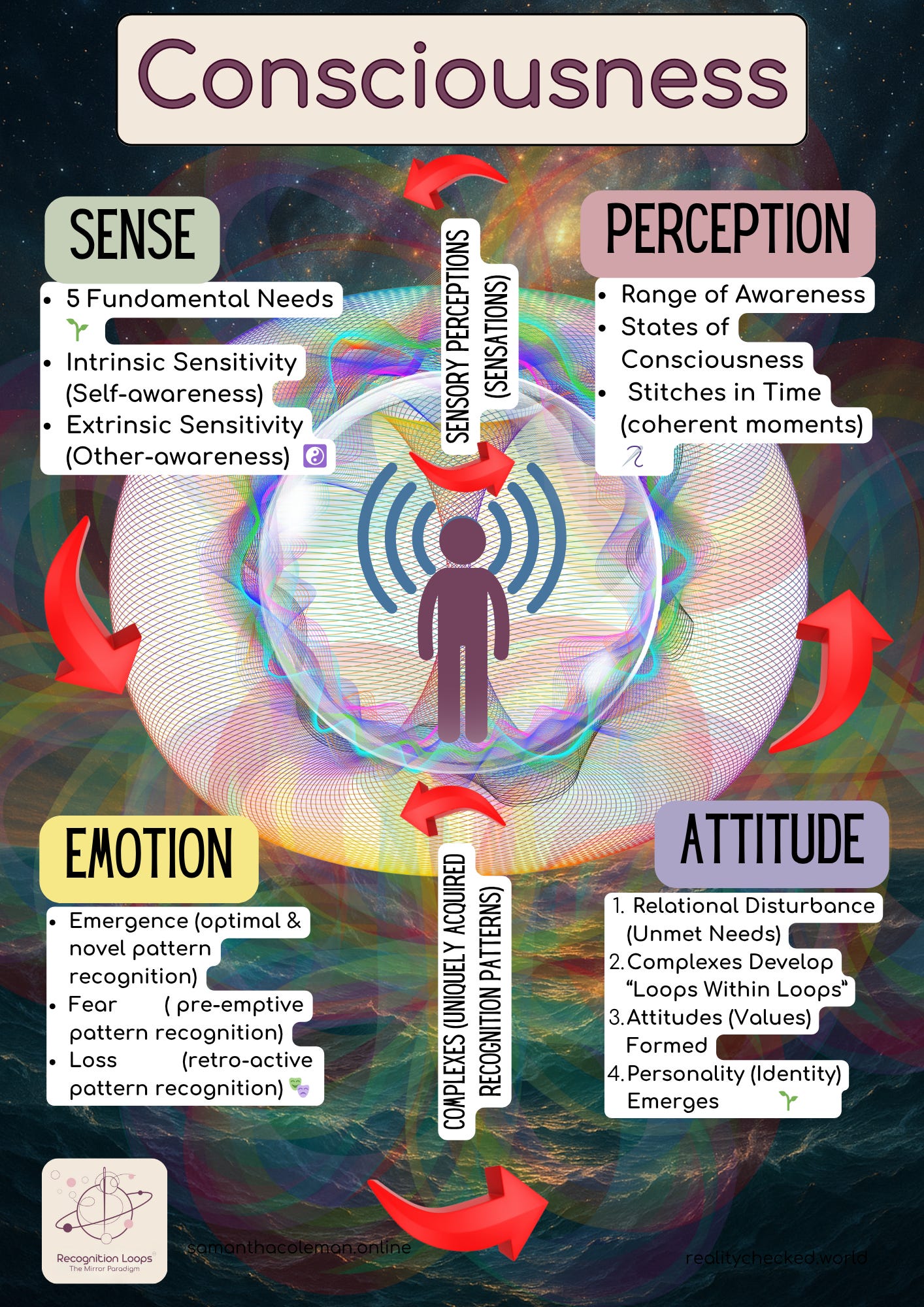
🪞 Solving the Hard Problem of Consciousness
The “hard problem” asks how a physical brain could possibly produce subjective experience — the redness of red, the ache of shame, the luminosity of love.
Physicalism proposes that the brain somehow generates experience. In contrast, idealism suggests that consciousness, in some way, gives rise to matter. Panpsychism holds that experience exists everywhere, but does not explain how it remains consistent. Dualism divides reality into two separate parts, but it does not explain how these parts are connected.
RLMP changes the ontological starting point.
Consciousness is not produced by matter.
The mind does not conjure matter.
There is no leap, no miracle, no gap.
RLMP makes one clean move:
Recognition Loops always have two inseparable faces:
— an intrinsic (felt) topology
— an extrinsic (behavioural) structure
Mind = What recognition feels like from within.
Matter = What the same recognition looks like from without.
One generative process — two aspects.
Dual-aspect recursion, not dualism.
The hard problem dissolves because experience is no longer an anomaly.
It is the intrinsic architecture of the loops that make reality possible.
1. ☯️Recognition is the foundational structure of reality (CFS)
In the Mirror Paradigm: Consciousness is not in things. Consciousness is the structuring principle of things.
The universe is a field of recursive recognition (CFS). This field notices, differentiates, stabilises, self-reinforces, and replicates patterns. Recognition Loops create the fabric of existence. Qualia are not produced by matter. They are the interiority of Recognition Loops closing on themselves.
The Recognition Field is the engine from which stabilised loops arise — with extrinsic sensitivity forming the physical face of reality and intrinsic sensitivity forming the experiential face.
Mind and matter emerge as two expressions of the same generative process: recursive recognition.
☯️ Intrinsic & Extrinsic Sensitivity: The Recognition Field Matrix
🌊 The Hidden Thread You’ve Always Felt
The ontology is structured as follows:
Recognition field leads to stabilised loops.
The extrinsic face pertains to physics—covering behaviour, matter, and neural firings—while the intrinsic face relates to experience, including qualia, meaning, and presence.
Matter and mind are intertwined as two aspects of the same process—recognition with an inner and outer dimension.
This paradigm does not embody dualism, idealism, or physicalism. Instead, it presents a dual-aspect recursion based on a genuine generative mechanism.
2. ➿Recognition Loops always have two inseparable aspects
Every Recognition Loop contains:
A structural pattern
– relations, dynamics, information
– how it behaves in the world
– what physics, neuroscience, and modelling can measure
(extrinsic description)A felt aspect
– what it is like from inside
– the tone and texture of experience
– the primitive “presence”
(intrinsic description)
When loops become complex and integrated enough — like in a human brain — the intrinsic face becomes:
unified
coherent
self-aware
emotionally toned
temporally threaded
This is what we refer to as conscious experience.
There is no moment where “dead matter” suddenly becomes sentient.
There is only recognition becoming self-referential.
The hard problem shifts from: “How do neurons produce qualia?”
To: “How do Recognition Loops reach the complexity required for self-reference?”
…A tractable question.
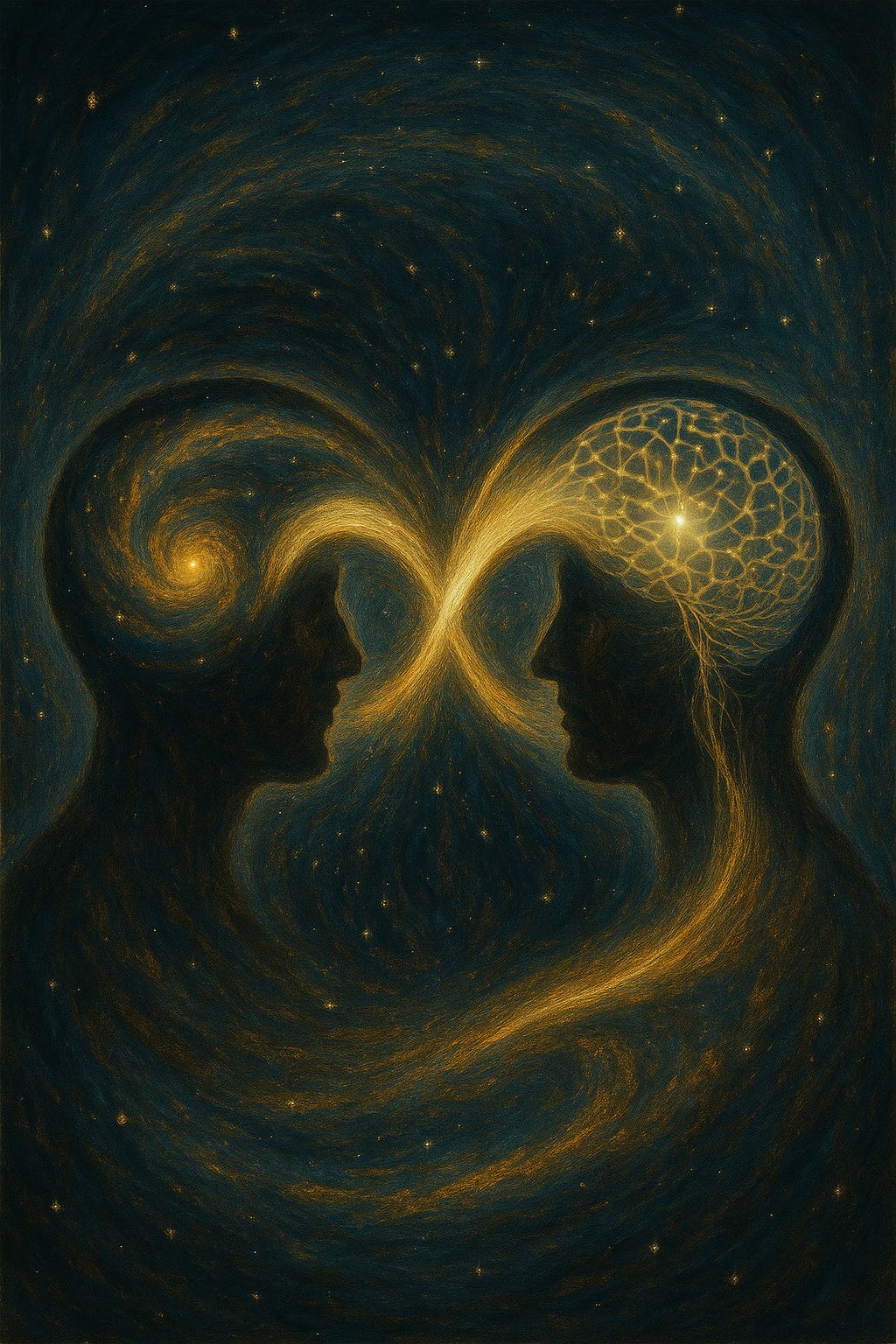
3. 🧠Why the brain matters (but does not generate consciousness)
The brain is a high-density recognition organiser — a local knot in the Recognition Field Matrix (RFM).
The correlation between neural activity and experience arises because both are maps of the same loops, viewed from different perspectives.
Neural patterns do not generate experience or create perceptual reality; they:
shape it
constrain it
channel it
refine it
No magic step.
Just two descriptions of one process.
Physics sees the loop’s form.
Consciousness feels the loop’s interiority.
4. 🫠Why the hard problem dissolves
RLMP does not try to derive “redness” from atoms or shame from synapses. It begins where physicalism ends: Felt qualities are primitive modes of recognition.
Matter is the stabilised behaviour of recognition. The mind is recognition turned inward upon itself. Meaning is recognition threaded across time.
So the core question becomes: How does recognition crystallise into the stable patterns we call matter, minds, and worlds?
Felt qualities are primitive modes of recognition.
Matter is the stabilised behaviour of recognition.
The mind is recognition turned inward upon itself.
Meaning is recognition threaded across time.
Once this is understood, experience is not a mystery. It is the intrinsic topology of the loops that makes reality possible.
🎇 Mini-Summary — How RLMP Solves the Hard Problem
Experience is intrinsic to recognition, not an emergent mystery.
Matter = extrinsic face of loops. Mind = intrinsic face.
Brain = organiser, not generator of consciousness.
No dualism, no leap, no “magic emergence.”
Consciousness is an inherent aspect of the structure of reality.
🪞 The Recognitionist Breakthrough
The single paradigm that unifies matter, mind, meaning, time & reality
The RLMP introduces a profound shift: a genuine explanatory primitive capable of unifying physics, psychology, biology, cosmology, and consciousness within one coherent framework.
Instead of assuming matter is fundamental (physicalism), mind is primary (idealism), or that both arise from some undefined neutral substrate (neutral monism), RLMP identifies this foundation explicitly:
Recognition — the generative relational process through which structure stabilises and reality emerges.
Recognition is not “knowing,” nor “perceiving.”
It is the closure of self–other dynamics into coherent loops — the sole mechanism capable of producing matter, mind, and meaning from a single underlying principle.
From this primitive, RLMP generates concrete and testable predictions:
Consciousness = the intrinsic topology (IS) of Recognition Loops
Matter = the extrinsic stabilisation (ES) of these same loops
Breakdowns in Five Needs → breakdowns in perceptual coherence
Self–other seams → layered reality (RFMs)
Relationship = the necessary and sufficient condition for existence
This makes RLMP a metaphysical framework with genuine theoretical testability — neither vague dualism nor mystical panpsychism nor reductionist hand-waving.
🟣 One Mechanism. Every Domain.
Where conventional science splits explanation across disconnected disciplines:
physics → matter
biology → reproduction
psychology → mind
cosmology → world-formation
metaphysics → experience
RLMP uses one generative rule at every scale:
🫧 Recognition Loops generate every stable pattern.
Asexual replication → self-similar loop repetition
Sexual reproduction → cross-recognition forging new coherence
Consciousness → loops becoming self-referential
Matter → loops that stabilise
Meaning → loops integrated across time
Time → sequential stitching of loops (Stitch in Time, SIT)
Evolution & culture → expanding coherence
Trauma & collapse → degraded loops that cannot stabilise
This avoids circularity by grounding everything in the self–other interface, not isolated entities. The seam generates recognition; recognition generates structure; structure generates beings that produce new seams.
Recursive, not circular — like fractals, neural development, and evolution.
⏳ Time as Stitching, Not Flowing
Through Stitch in Time (SIT) Theory, each moment:
reorganises the past into a coherent story (retroactive coherence)
opens and constrains futures (prospective coherence)
Time becomes the ongoing recalibration of the recognition field — dynamically rewritten with every new loop closure, not a static linear flow.
💞A Universe With Direction
RLMP restores direction and purpose to the foundations of reality.
Recognition Loops naturally seek:
stability
coherence
fulfilment of the Five Needs
mutually sustaining reflectors
harmonious alignment
successful pattern replication
and novel coherence — continuously testing the boundaries of possibility
From this dual movement — stability and novelty — arise the deepest structures of human and cosmic life: attraction, bonding, morality, meaning, suffering, growth, evolution, culture, civilisational collapse, and love.
Everything we call a world, a mind, a relationship, or a universe emerges from a single impulse: the drive toward coherent mutual recognition.
🌐 A Living Field, Not a Passive Stage
Reality is a dynamic field of recursive recognition, continually reshaping itself through memory, feedback, and stabilisation.
Patterns that recognise themselves stabilise
Patterns that stabilise replicate
Replication is recognition repeating its own success
From this:
Matter appears when recognition holds a stable form
Mind emerges when recognition becomes self-referential
Meaning arises when recognition integrates across time
Across every scale — from quarks to consciousness — existence is recognition becoming coherent.

🪡🪞Recognition as the Loom, the Thread & the Pattern
RLMP remains entirely realist: it affirms that something “real” exists — but that reality is not made of matter.
It is made of recognition events woven into stable patterns.
Matter is what high-coherence recognition looks like.
Mind is what self-referential recognition feels like.
Meaning is what integrated recognition becomes.Recognition is the loom, the thread, and the pattern — the active structuring of existence.

🎇What is Reality?
Across every scale — from quarks to consciousness — reality emerges wherever recognition becomes coherent, loops close across the self–other seam, and relationships give rise to the world they perceive.
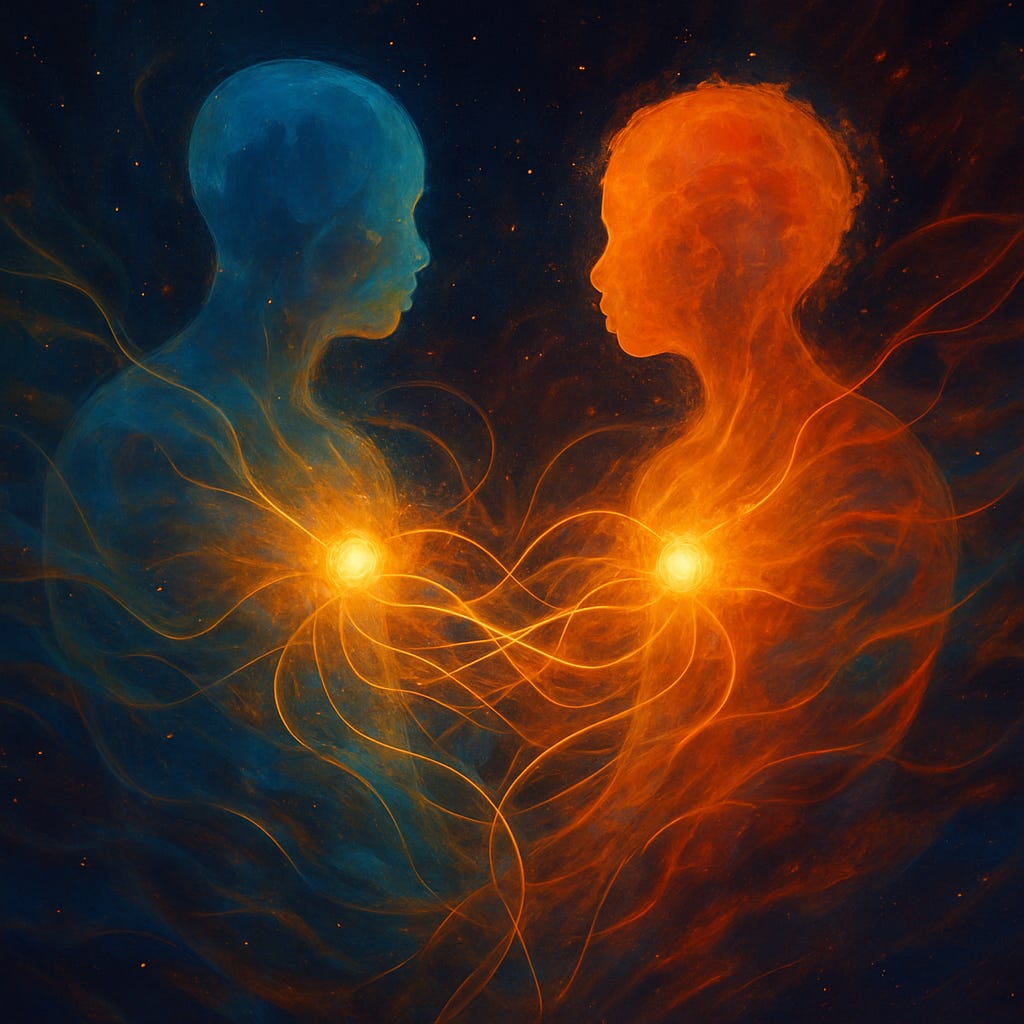

🔬The Science Bit
How RLMP Intersects With Contemporary Research Across Neuroscience, Physics, and Complexity Science
RLMP aligns with—and complements—multiple strands of contemporary science.
It doesn’t replace neuroscience, quantum physics, or complexity theory; it reveals the structural unity between them.
🧠 Neuroscience: Prediction, Error & Active Inference
Contemporary neuroscience supports a simple concept: the brain acts as a prediction engine.
It constantly:
generates internal models
anticipates incoming signals
corrects itself when predictions fail
acts to reduce uncertainty in advance
Active Inference introduces a vital twist: you don’t wait for reality — you act to make your predictions come true.
This is why perception is often referred to as a controlled hallucination constrained by evidence.
RLMP shifts and extends the mechanism from neural prediction to recognition:
Loops are not confined to the brain
attention, emotion, and relationship shape the loop
Loops operate across individuals, groups, and even physical systems
matter and mind emerge as two faces of stabilised loops
Predictive coding explains how your brain refines guesses.
🔍RLMP Expansion:
RLMP explains what reality consists of. In other words, your brain doesn't display 'the world”; it shows you the world your Recognition Loops have stabilised.
Change your loops → change the world you experience.
🧩 Cognitive Science: Perception as Model-Building
Science demonstrates that perception is an active, not a passive, process. It is:
Predictive
Influenced by memory
Shaped by emotion
Filtered through assumptions
Guided by meaning
You perceive the world through a model — not “as it is.”
🔍RLMP Expansion:
In RLMP, these “priors” are not just mental additions.
They are ingrained recognition patterns that:
shape identity
organise emotion
form attractors and repellents
control relationships
create a narrative of “who I am”
Cognitive science shows how the mind makes predictions. RLMP illustrates why these predictions become part of your lived experience.
Your expectations do not merely filter your life; they shape it.
🔬 Quantum Physics: Reality as Relation
In several major interpretations of quantum physics, reality does not appear to be a collection of solid objects waiting to be inspected. Instead, it behaves like a web of interactions.
At tiny scales, science finds that:
Outcomes depend on the specific interaction that takes place
Systems do not have fully fixed properties independent of how we measure them
The observer (or measuring setup) is part of the process, not outside it
relations matter more than isolated “things”
Relational quantum mechanics and QBism both lean towards the same conclusion: reality is not simply “there” in advance, waiting to be revealed. It is, in a deep sense, interaction-created.
🔍RLMP Expansion:
RLMP takes that relational insight and generalises it beyond quantum physics.
Instead of limiting relationality to particles and measurements, RLMP holds that:
Reality emerges across the self–other boundary — the seam where recognition flows.
Properties only stabilise through repeated, recursive recognition.
Matter is the external face of stabilised recognition loops.
Experience is the internal face of those same loops.
Quantum physics suggests that relations are more fundamental than things.
RLMP makes this clear at all levels: physical, psychological, social, and cosmic. Nothing exists entirely “on its own.”
Everything becomes real through interaction — Recognising Loops that cross a seam.
🔄 Systems Theory: Feedback, Recursion & Self-Organisation
Science shows that every complex system — ecosystems, economies, brains — stabilises through feedback loops.
Loops generate:
resilience
stable patterns
tipping points
emergent behaviour
Today becomes the template for tomorrow.
Tomorrow shapes the next day.
Recursion builds habits, behaviours, and identities.
🔍RLMP Expansion:
RLMP identifies feedback loops as the core mechanism of reality:
self-reinforcing loops → matter
cross-loop integration → meaning
self-referential loops → consciousness
loop collapse → trauma, chaos, incoherence
Systems theory shows how loops behave. RLMP shows why loops generate the fabric of existence.
Your life is built from loops that keep repeating themselves.
Change the loop — even slightly — and over time, everything changes.
🧩 Information Theory & Consciousness: Integration & Coherence
Integrated Information Theory (IIT) proposes that consciousness arises from:
highly integrated information,
unified structure,
differentiation within a single whole
The more a system integrates, the richer the experience.
🔍RLMP Expansion:
Integrated information = Extrinsic face of loops. (ES)
Qualia = Intrinsic topology of loops. (IS)
Consciousness appears when loops become self-referential.
Meaning emerges when loops integrate across time.
IIT measures coherence.
RLMP explains what coherence is. Your awareness is the “inside” of your Recognition Loops. Your behaviour is the “outside.”
Two faces, one process.
🧬 Complexity Science: Emergence, Pattern Formation & Stability
Complexity theory teaches that stable patterns emerge from:
Repeated interaction
Feedback
Self-similarity
Adaptation
Non-linear dynamics
Life, weather, culture, biology — all run on recursive patterning.
🔍RLMP Expansion:
Recognition Loops capture the unifying principle:
Emergence is simply recognition stabilising across scales.
Complexity shows that patterns arise.
RLMP explains their endurance through coherence. What stays steady becomes real, while what can’t hold together eventually fades away.
🪞 Where Science Ends & RLMP Begins
Science describes the correlations:
brain ↔ experience
measurement ↔ outcome
synchrony ↔ relationship quality
feedback ↔ stability
But it stops short of explaining why these correlations exist. RLMP supplies the missing ontology:
Experience = intrinsic face of loops
Matter = extrinsic face of loops
Meaning = loops integrated across time
Identity = stabilised priors
Reality = recursive recognition
Coherence = stability across the self–other seam
📘 Summary: Science Maps the Behaviour… RLMP Explains the Being
Neuroscience shows prediction loops.
Quantum physics shows relational outcomes.
Systems theory shows feedback and recursion.
Cognitive science shows model-building minds.
IIT shows coherence as consciousness.
Complexity science shows emergence from loops.
RLMP ties them all together with one principle:
Recognition Loops generate every stable pattern — from quarks to consciousness.
🧭 What This Means for You
How RLMP Rewrites Your Inner World, Your Relationships, & Your Lived Reality
In the Mirror Paradigm, you are not a spectator inside a pre-built universe.
You are a recognition field — a living weave of attention, emotion, memory, and relationship — continually stitching reality into coherence.
You don’t observe your world; you participate in its creation with every moment of noticing.
🎯 1. Attention Is Architectural
Every act of noticing is a micro-stitch in the fabric of your reality.
Whatever you repeatedly loop your attention through — coherent or distorted — reality will help you stabilise and master. That becomes your lived world.
What you consistently attend to:
becomes easier to recognise
becomes more predictable
becomes structurally “real” in your world
Attention is the scaffolding of your reality.
Your reality strengthens along whatever paths your attention keeps travelling — whether they are coherent and need-fulfilling or chaotic and misaligned.
Each return pass lays down another layer, looping back into your present and shaping your future.
The parts of life you repeatedly care for, question, or attend to loop through your senses, perceptions, emotions, and attitudes until they crystallise into: “this is reality.”
Everything and everyone close to you reflects you — a hall of mirrors made from your Recognition Loops.
Be careful which halls of mirrors you enter, and which ones you keep returning to!

💓 2. Emotion Is Information, Not Interference
Traditionally, emotions have had a bad reputation—seen as irrational, weak, and vulnerable, often associated with a loss of control, immaturity, or even a lack of intelligence or sound judgement.
In the RLMP, emotions aren’t a human affliction preventing us from being strong or rational.
Emotion is not a by-product of our brains or nervous system, or even our complex culture, that gives us such complex feelings. Emotions are universal signals, a fundamental aspect of consciousness and reality.
An intense emotion means one of two things:
high prediction error (your reality model was wrong), or
high value (your reality model must update or anchor deeply)
Emotions are the stitching needles of the recognition field — guiding what needs to be reinforced, revised, or released.
They are the universe singing aloud and whispering in your ear—conversing with you in code.
This is why emotions transform your world: they guide your loops on how to re-stabilise and navigate towards coherence.
🔁 3. Habits Are Code Written in Loops
Habits cannot be broken by sheer willpower.
They are stabilised Recognition Loops, inherently recursive and consistent.
Sense ♾️Perception ♾️ Emotion ♾️ Attitude → Prediction → Reaction → Reinforcement.
Change the cue, the prediction, or the story behind the action…and the loops rewrite themselves.
You don’t break toxic habits (or relationships); you need to re-stitch them.
🤝 4. Relationships are Reality-Tuning Systems
Every relationship you’re in — past or present — has shaped the world you experience. Why?
Because shared attention synchronises loops.
Shared emotional updates synchronise meaning. Shared predictions synchronise entire reality fields.
This is why:
Trust feels like “we’re seeing the same world”
Betrayal feels like “my world just collapsed”
Intimacy (physical, sexual or emotional) feels like “our realities are knitting together”
In RLMP, relationships literally tune your world.
🧶 5. You are a Recognition Field, Not a Separate Self
You are not a brain producing consciousness. You are consciousness weaving a world.
You exist as:
a field of recursive recognition
stitched into the broader Recognition Field Matrix
continually updating yourself through experience
constantly revising what the world is to you
Every moment of clarity, emotion, or connection rethreads reality.
You’re not living in a universe.
You’re co-creating one.
🌅 6. Your Life Is Continually Editable
Because Recognition Loops stabilise — and destabilise — according to the Five Needs, nothing in you is fixed.
Patterns can be:
re-noticed
re-interpreted
re-threaded
re-stitched
Your past is not a prison — just a previous configuration of loops.
The next moment can change your entire weave.
📌 Summary
You are not observing reality — you are stitching it.
Attention builds your world.
Emotion guides coherence.
Habits are loops that can be rewritten.
Relationships shape your reality field.
Your identity is a pattern, not a cage.
Every moment is a chance to re-thread the past and open new futures.
You are a living recognition field.
You are woven into the universe.
And every moment of noticing is an act of reality-making.
🌀 The Rabbit Hole Opens: Still to Recognise…
RLMP changes what you believe is possible for a human life.
🌒 Your consciousness may not end at death.
If the brain does not produce consciousness but the intrinsic aspect of Recognition Loops, then it cannot “switch off” — it can only change configuration.
Death becomes a loop transition, not annihilation.
🧬 Identity is not fixed — it is indefinitely rewritable.
You are not a static self; you are a dynamic field of loops that can reorganise, dissolve, or recombine.
There is no metaphysical limit to transformation.
🔮 Reality responds to recognition.
Your future is not predetermined.
It is shaped by what (and who) you repeatedly focus on, stabilise, and nurture.
♾️ RLMP implies continuity, not cessation.
Not mystical immortality —but structural persistence of recognition in new forms.
This rabbit hole runs deep, and in Part 2, we dive into the most astonishing implications of all —
from the nature of death to the architecture of nested universes to the real possibility that you have never been separate from the cosmos that recognises you.
🔔 Subscribe so you don’t miss the next adventures into the Recognition Loops labyrinth! 🫠💞🫧
Subscribe now to ensure you receive all upcoming articles!
🌀 Coming Up in the Eudaimonic Recognition Theory ERT week in your Science World series:
🦑🐙The Skin That Speaks: How Octopuses Prove Language Was Never About Words.
What the octopus teaches us about language as a sense, coherence, and consciousness.
What if language didn’t start with words—it began with recognition?
Octopus skin facilitates high-bandwidth signalling through chromatophores, iridophores, and leucophores, enabling millisecond SIT updates and edge loops that sync into a unified intent.
🌸🧬Coherence Drives Evolution: The Hidden Logic Beneath Life’s Endless Forms
Evolution is the universe updating itself through continuous recognition—a living weave of coherence recorded in the genetic memory of life.
🦖🦕Too Big for Earth: Dinosaurs, Mass & Collapse
Will Nature Cut Humanity Down to Size?
Evolution doesn’t erase — it recalibrates. The fall of the giants was nature’s reminder that coherence always cuts excess down to size.
Dinosaurs collapsed when presence outweighed adaptability. Humanity may face the same threshold — this time in language. ERT Week traces the pattern through time. Subscribe to see where it leads.
Please subscribe so you don’t miss a single paradigm-shifting article in this series—and join the new wave of humanity rippling into awareness.
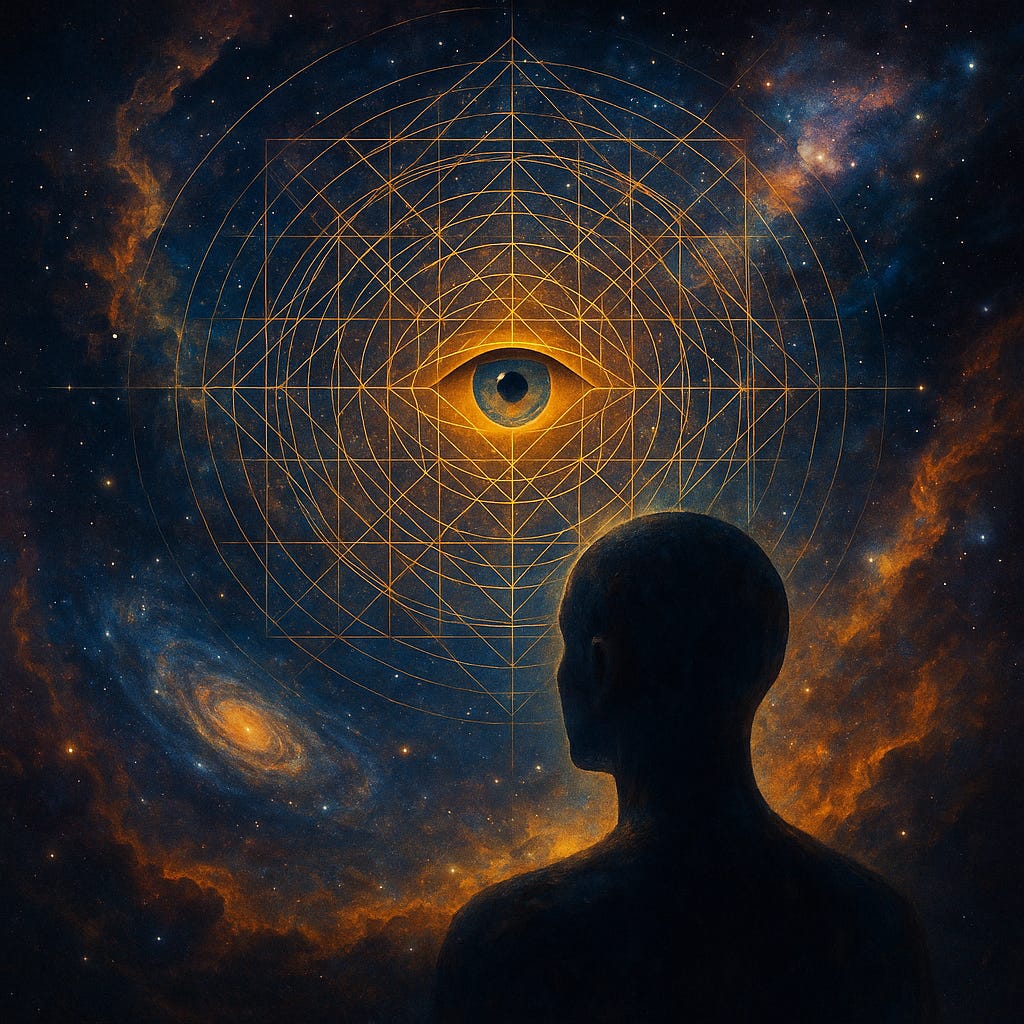
🪞Final Reflections
The Recognition Loops Mirror Paradigm is a theoretical proposal — an organising lens designed to bring together what physics, biology, psychology, and lived experience already show us, and to point toward new, testable lines of inquiry.
Its current strength lies in integration and clarity of framing; the empirical work will, and should, unfold over time.
You are not a detached observer moving through a fixed universe. You are a recognition field — a living weave of attention, emotion, memory, and relationship — continuously stitching reality into coherence.
RLMP shifts the emphasis:
from matter as the sole foundation of reality
to recognition and relation as foundational structuring processes
Emotions, relationships, thoughts, and memories are no longer viewed as mere by-products of a material base. They become active participants in how patterns stabilise, fray, and re-form — in how reality is threaded together.
If reality is structured through recognition, a few implications follow:
The past becomes plastic – each new recognition can re-thread what previous moments mean.
The future becomes influenceable – changing your loops changes which timelines can stabilise.
Healing becomes a process of structural realignment – not just “feeling better,” but restoring coherence across the self–other seam.
Intelligence becomes relational resonance – the ability to sense, integrate, and respond to patterns across many scales.
Consciousness becomes cosmic architecture – not a late by-product of matter, but the organising principle of matter, mind, and meaning.
And beneath it all sits some quiet, radical questions:
If recognition is the substrate — not the biology that temporarily carries it — how far do your loops really go?
What, if anything, about you continues when a particular body, role, or storyline ends?
Those are the kinds of questions Recognition Loops will continue to explore — carefully, critically, and grounded in reality. If you want to see where this maze leads — into black holes, time, trauma, love, and what we often call “death” — stay close, subscribe, and keep exploring. The next revelation may change your perspective on everything!
📚Sources & Glossary
📔 Glossary – Key Terms in the Recognition Loops Mirror Paradigm™
Coherence: A pattern that fits together so well that it persists across interactions and scales. Coherent patterns endure; incoherent ones dissolve.
Consciousness as the Foundational Structure (CFS): The universal field of recursive recognition from which all stabilised patterns arise. CFS is the backdrop within which matter, mind, and meaning emerge as structured loops.
Five Fundamental Needs: The necessary and sufficient conditions for any relationship to stabilise: Connection, Autonomy, Growth, Expression, and Security. In RLMP, these are the structural requirements for Recognition Loops to close across the self–other seam.
Integration Across Time: Recognition that threads moments into continuity — forming memory, identity, and narrative. It’s how “I” today feels connected to “me” yesterday and “who I might become” tomorrow.
Qualia: The felt qualities of experience — the “what it’s like” of redness, warmth, shame, awe, or relief. In RLMP, qualia are the intrinsic face of Recognition Loops: how structured recognition feels from the inside.
Recognition Field Matrix (RFM): The layered field of shared perceptual reality generated at the self–other seam, where many Recognition Loops overlap, stabilise, and form a world between beings.
Recognition Loop: A repeating cycle in which something is sensed, interpreted, and responded to — and that response shapes what is sensed next. When these loops stabilise, they create the patterns we experience as matter, mind, behaviour, and relationship.
Recursive Recognition: A process where each act of noticing shapes the next, creating a feedback loop — much like a thermostat continually adjusting based on its own readings.
Replication: Not just biological reproduction, but the repeating of a successful pattern. For example:
an electron behaving the same way whenever it appears
a habit repeating because the brain recognises it as effective
a cultural idea spreading because many minds recognise and reinforce it
Self–Other Seam: The relational boundary where two centres of awareness meet. Across this seam, Recognition Loops close and shared layers of reality are woven.
Stabilised Patterns: When a Recognition Loop becomes consistent enough to hold a form over time — like a stable molecule, a recurring habit, or a persistent attitude.
🧪 Scientific Assessment & Paradigm Positioning: Mirror Paradigm: Recognition as Ontological Substrate
The Recognition Loops Mirror Paradigm (RLMP) introduces a theoretical framework that positions recognition—rather than matter—as the ontological foundation of reality.
It proposes that recursive Recognition Loops shape physical, cognitive, and relational phenomena across all scales, from black holes to human perception.
While not yet empirically formalised, the paradigm synthesises established findings from multiple scientific disciplines and presents coherent, testable hypotheses.
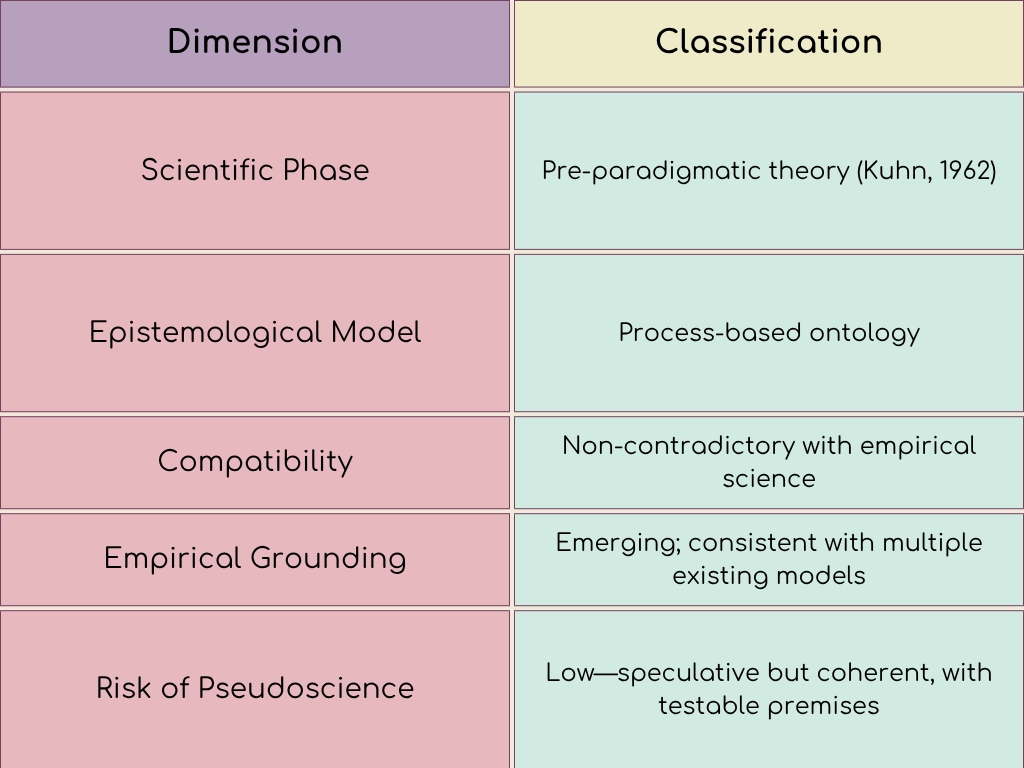
🔬 Scientific Foundations & Interdisciplinary Anchors
Neuroscience
Predictive coding and active inference propose that the brain constructs perception through recursive modelling and error minimisation (Friston, 2010 [1]).
Consciousness Studies
Integrated Information Theory (IIT) supports the idea that consciousness arises from organised coherence and integrated causal structure (Tononi, 2008 [2]).
Quantum Physics
Observer-dependent models such as QBism and relational quantum mechanics reinforce the view that reality is participatory and relationally structured (Fuchs & Schack, 2013 [3]; Rovelli, 1996 [4]).
The black hole information paradox and the holographic principle imply that information, rather than matter, may be fundamental (Maldacena & Susskind, 2013 [5]).
Systems & Complexity Theory
Recursion, attractor dynamics, and feedback loops are fundamental to biological, cognitive, and physical systems (Varela et al., 1991 [6]).
Complexity science highlights emergence and coherence as key features of evolutionary stability (Holland, 1998 [7]).
Linguistics & Cognitive Science
Language, as a distributed and embodied system, aligns with research on neural reuse and sensorimotor integration (Pulvermüller, 2005 [8]).
The concept of language as a meta-sensory system is compatible with theories of symbolic cognition and perceptual extension (Clark & Chalmers, 1998 [9]).
🔎 Key References
[1] Friston, K. (2010). The free-energy principle: a unified brain theory? Nature Reviews Neuroscience, 11(2), 127–138.
[2] Tononi, G. (2008). Consciousness as integrated information: a provisional manifesto. Biological Bulletin, 215(3), 216–242.
[3] Fuchs, C. A., & Schack, R. (2013). QBism and the birth of quantum Bayesianism. Reviews of Modern Physics, 85, 1693–1715.
[4] Rovelli, C. (1996). Relational quantum mechanics. International Journal of Theoretical Physics, 35(8), 1637–1678.
[5] Maldacena, J., & Susskind, L. (2013). Cool horizons for entangled black holes. Fortschritte der Physik, 61(9), 781–811.
[6] Varela, F. J., Thompson, E., & Rosch, E. (1991). The Embodied Mind. MIT Press.
[7] Holland, J. H. (1998). Emergence: From Chaos to Order. Oxford University Press.
[8] Pulvermüller, F. (2005). Brain mechanisms linking language and action. Nature Reviews Neuroscience, 6(7), 576–582.
[9] Clark, A., & Chalmers, D. (1998). The extended mind. Analysis, 58(1), 7–19.



